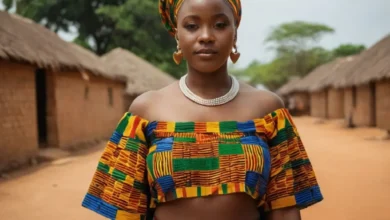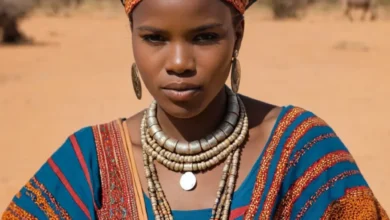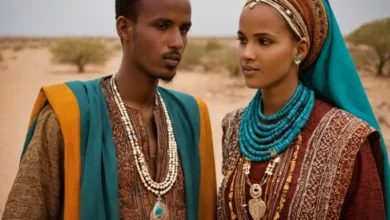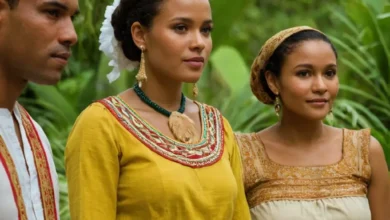Comorian Traditional Clothing
The Comoros, a volcanic archipelago nestled in the Indian Ocean, boasts a rich and vibrant cultural heritage that is reflected in its diverse traditional clothing. Comorian attire is a captivating tapestry woven from the threads of African, Arab, and Islamic influences, resulting in a unique and elegant style that speaks volumes about the islands’ history and identity.
A Journey Through Time: The Evolution of Comorian Dress
The Comorian dress code has evolved over centuries, absorbing influences from the various cultures that have touched the islands. The earliest influences can be traced back to the African mainland, where the Bantu people, ancestors of the Comorians, brought with them their own distinct fashion sensibilities. These early garments were primarily made of natural materials like bark cloth, leather, and animal skins, reflecting the practical needs of their agrarian lifestyle.
With the arrival of Arab traders and the spread of Islam in the 10th century, Comorian clothing underwent a significant transformation. The influence of Islamic dress codes, emphasizing modesty and covering, became prominent.
Loose, flowing garments became the norm, with the kanga (a rectangular cloth) and the djellaba (a long, loose robe) gaining widespread popularity. These garments, often adorned with intricate embroidery and vibrant colors, reflected the newly adopted Islamic beliefs and the growing trade connections with the Arabian Peninsula.
See also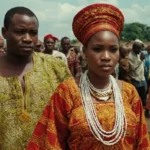 Congolese Traditional Clothing: From Liputa to Other Cultural Attire
Congolese Traditional Clothing: From Liputa to Other Cultural Attire
The arrival of the French in the 19th century further shaped Comorian fashion. The French introduced new fabrics like cotton and silk, as well as tailoring techniques that resulted in the emergence of more structured garments. This fusion of traditional styles with European influences gave rise to the modern Comorian dress code, a unique blend of the past and present.
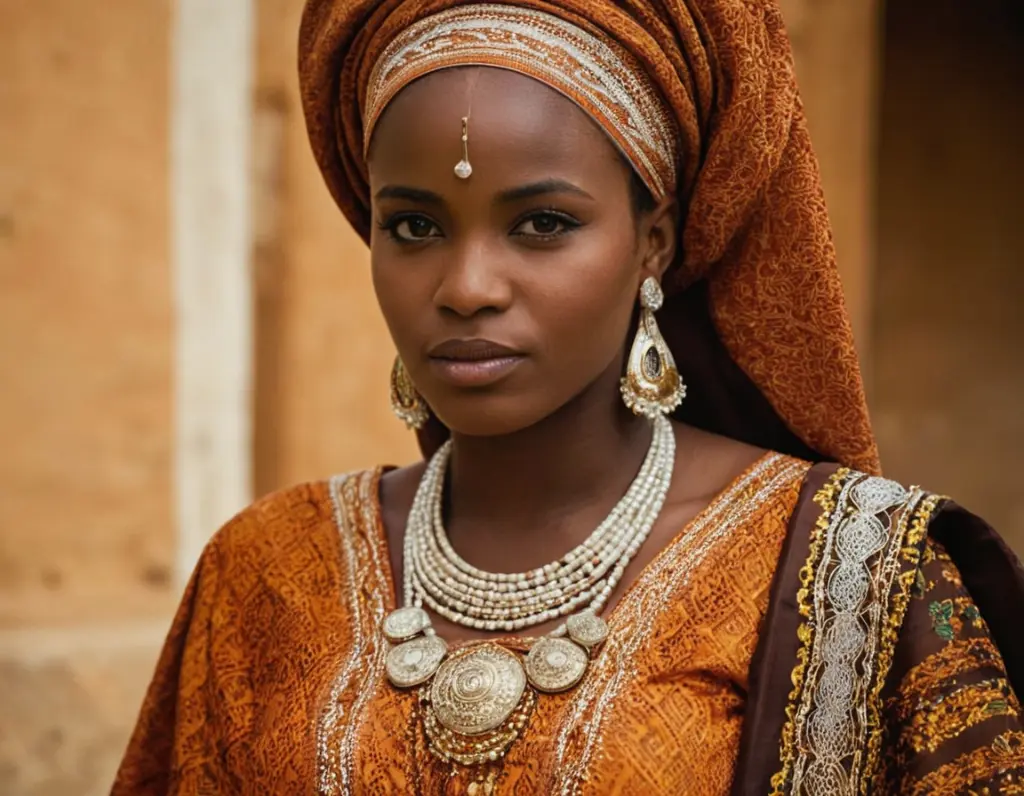
A Glimpse into Comorian Traditional Attire
The Comoros, like many other cultures, maintain distinct dress codes for men and women. These garments are not merely clothes; they represent identity, social status, and religious beliefs.
Women’s Attire: A Symphony of Elegance and Modesty
Comorian women are known for their graceful and elegant attire. The cornerstone of their wardrobe is thekanga, a rectangular cloth that serves multiple purposes. It can be worn as a shawl, a head covering, a skirt, or even a baby carrier. Often adorned with intricate patterns and vibrant colors, the kanga is more than just a garment; it’s a cultural symbol, representing identity, social status, and sometimes carrying messages or proverbs.
Another essential element of Comorian women’s attire is the buibui, a loose, flowing garment that covers the body from the neck to the ankles. The buibui can be made from various fabrics, including cotton, silk, and synthetic materials, and is often embellished with embroidery, beads, or sequins.
See also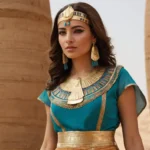 Egyptian Traditional Dress: From Ancient Pharaohs to Modern Styles
Egyptian Traditional Dress: From Ancient Pharaohs to Modern Styles
Comorian women also wear headscarves, known ashijab, which are essential for religious modesty. These headscarves come in various colors and fabrics, often complementing the kanga and buibui. The khmissa, a traditional cap that covers the hair and neck, is also widely worn.
Completing the ensemble are jewelry and accessories. Comorian women adorn themselves with intricate necklaces, earrings, bracelets, and rings, often made of gold, silver, or beads. The jewelry not only adds a touch of beauty but also conveys social status, religious affiliations, and family heritage.
Men’s Attire: Simplicity and Functionality
Comorian men’s attire, while equally steeped in tradition, prioritizes simplicity and functionality. The staple garment is the kanzu, a long, loose tunic that reaches down to the ankles. Made from cotton or linen, the kanzu is often worn with a kofia, a traditional cap that covers the head, symbolizing respect and piety.
Comorian men also wear trousers, typically made of cotton or linen, and sandals or slippers. Some men, especially in rural areas, wear turbans, which signify respect, status, and religious affiliation.
The kanga plays a significant role in men’s attire as well. It can be worn as a sash or a wrap, adding a touch of color and style to their outfits. In some regions, men also wear the djellaba, a long, loose robe that is often worn over the kanzu, especially during religious ceremonies or special occasions.
Special Occasions: A Celebration of Tradition
Comorian traditional clothing takes on even greater significance during special occasions, such as weddings, religious ceremonies, and festivals. These events are marked by a vibrant display of color, intricate embroidery, and elaborate jewelry.
Weddings, for example, are a spectacle of vibrant hues and intricate detailing. The bride often wears a beautiful dress, adorned with sequins, beads, and intricate embroidery, showcasing the craftsmanship of local artisans. The groom typically wears a kanzu made of luxurious fabric and embellished with decorative stitching.
Religious ceremonies also see a distinct display of traditional attire. The kanga, the buibui, and the kanzu, all signifying respect and faith, are the garments of choice for such occasions. The colors and patterns of these garments can vary depending on the specific ceremony and the region.
Comorian festivals offer a glimpse into the diversity of their cultural heritage. These vibrant celebrations often see people adorned in traditional attire, reflecting the various ethnic groups and regional identities that make up the Comoros. The kanga, the buibui, and the kanzu, along with other regional variations, add to the colorful tapestry of these celebrations.
The Symbolism of Comorian Clothing: Beyond Fabric and Thread
Comorian traditional clothing is more than just garments; it’s a powerful visual language that speaks volumes about the country’s rich heritage and cultural identity. Every element, from the fabric to the embroidery and the accessories, carries specific meanings and symbolism.
The kanga, for instance, is not just a piece of cloth; it’s a cultural icon that embodies the strength, resilience, and resourcefulness of Comorian women. The intricate patterns and colors woven into the kanga often symbolize proverbs, wisdom, and cultural beliefs. It can also be used to communicate messages, express emotions, and even mark social status.
The buibui, with its loose and flowing design, reflects the values of modesty and privacy deeply rooted in Comorian society. The choice of fabric, the embroidery, and the color can also signify social status, regional identity, and religious affiliation.
The kanzu and the kofia, worn by men, symbolize respect, piety, and Islamic faith. The loose and flowing design of the kanzu provides comfort and practicality, while the kofia, placed on the head, signifies deference and humility.
The jewelry, with its intricate designs and precious materials, often reflects family lineage, social status, and religious beliefs. The use of beads, silver, and gold speaks volumes about the history of trade and cultural exchange that has shaped the Comoros.
Comorian clothing, therefore, is not simply a matter of fashion; it’s a profound expression of cultural identity, religious beliefs, and the values that have been passed down through generations. Every element, from the fabric to the cut and the embellishments, contributes to a unique and powerful visual narrative.
Preservation and Modernization: A Delicate Balance
In a world where globalization and modernization are constantly reshaping cultural landscapes, the preservation of traditional clothing poses a challenge. The younger generations, exposed to global fashion trends, often find themselves torn between the allure of modern attire and the importance of their heritage.
The Comoros, like many other societies, faces this challenge. While some young people embrace modern fashion, there is a growing awareness of the importance of preserving their cultural heritage. This has led to a growing trend of reinterpreting traditional garments, merging traditional elements with modern designs to create a contemporary style that honors the past while embracing the present.
Fashion designers and artists are playing a crucial role in this process. They are reinterpreting traditional patterns, colors, and fabrics to create modern pieces that are both fashionable and culturally relevant. This fusion of tradition and modernity is not only preserving the cultural heritage of the Comoros but also creating a new generation of Comorian fashion that is both stylish and meaningful.
The Future of Comorian Traditional Clothing: A Story of Resilience and Innovation
The future of Comorian traditional clothing is bright. With the growing awareness of the importance of preserving cultural heritage, there is a renewed appreciation for the rich tapestry of Comorian dress. The younger generation, increasingly embracing their cultural identity, is playing a vital role in ensuring that their ancestors’ legacy continues to inspire future generations.
The Comoros’ unique blend of African, Arab, and Islamic influences has created a distinct style that is both elegant and meaningful. As the country continues to evolve, its traditional clothing will continue to be a powerful symbol of resilience, creativity, and the enduring spirit of its people.
FAQs: Comorian Traditional Clothing
What are the main influences on Comorian traditional clothing?
Comorian traditional clothing is a fascinating blend of African, Arab, and Islamic influences. The early influences stemmed from the Bantu people, who brought their own fashion sensibilities from the African mainland.
The arrival of Arab traders and the spread of Islam in the 10th century introduced loose, flowing garments like the kanga and the djellaba, emphasizing modesty and covering. The later arrival of the French in the 19th century introduced new fabrics and tailoring techniques, adding a touch of European influence to Comorian attire.
What are some common garments worn by Comorian women?
Comorian women are known for their elegant and graceful attire. The kanga, a rectangular cloth that serves multiple purposes, is a staple garment. They also wear the buibui, a loose, flowing garment that covers the body from the neck to the ankles, and headscarves like the hijab for religious modesty.
The khmissa, a traditional cap that covers the hair and neck, is also commonly worn. Comorian women also adorn themselves with intricate jewelry, adding a touch of beauty and conveying social status, religious affiliations, and family heritage.
What is the significance of traditional clothing in Comorian culture?
Comorian traditional clothing is more than just garments; it’s a powerful visual language that speaks volumes about the country’s rich heritage and cultural identity. Every element, from the fabric to the embroidery and the accessories, carries specific meanings and symbolism.
The kanga, for instance, represents the strength and resourcefulness of Comorian women, while the buibui reflects the values of modesty and privacy. The kanzu and the kofia, worn by men, symbolize respect, piety, and Islamic faith. Comorian clothing is a profound expression of cultural identity, religious beliefs, and the values that have been passed down through generations.
Comorian traditional clothing is a captivating testament to the rich cultural tapestry of the Comoros. It’s a fascinating blend of African, Arab, and Islamic influences, resulting in a unique and elegant style that reflects the islands’ history, identity, and values.
From the intricate patterns of the kanga to the flowing grace of the buibui, Comorian dress is a visual language that speaks volumes about the enduring spirit of its people. As the Comoros navigates the challenges and opportunities of modernization, the preservation and reinterpretations of its traditional clothing ensure that this vibrant cultural legacy continues to inspire and unite its people.
